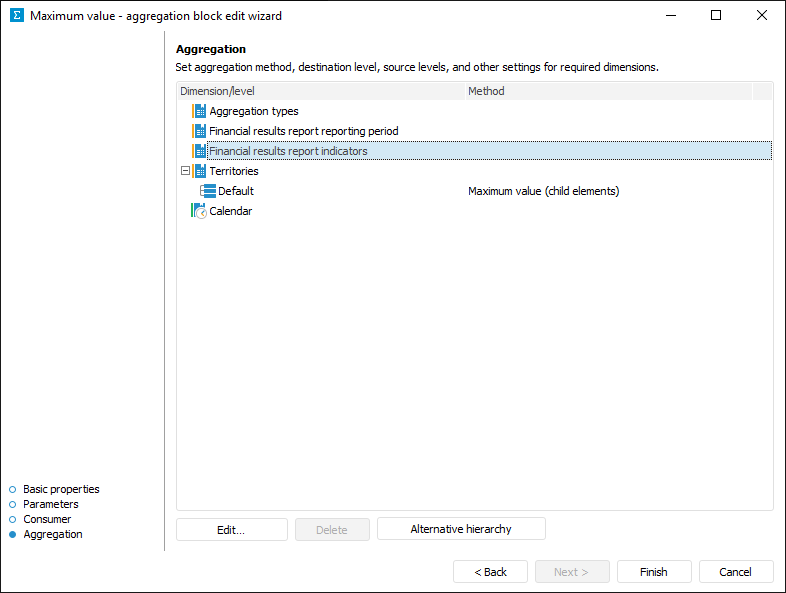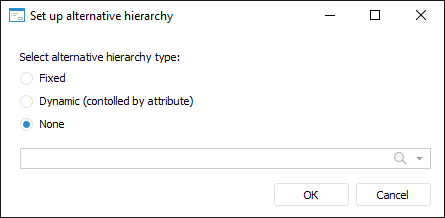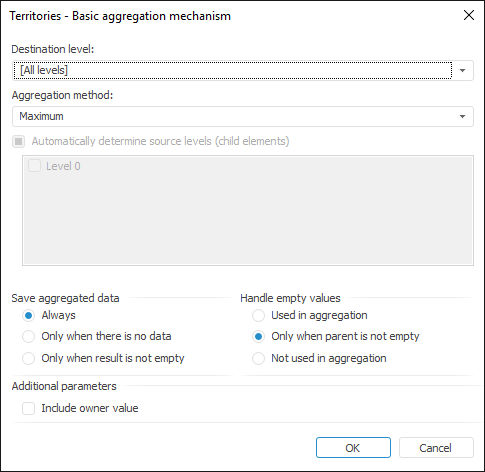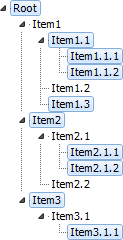
Aggregation setup determines, data by dimensions will be aggregated and by which method.
Aggregation can be set up on the Aggregation page in the aggregation block editing wizard:

To set up dimension aggregation:
Select the dimension to be aggregated.
Click the Edit button or double-click the scenario. The Set Up Aggregation dialog box opens, in which set dimension aggregation parameters.
If alternative hierarchy is set for the dimension, if required, select alternative hierarchy to calculate by alternative dictionary elements instead of the elements of the source dictionary or set up dynamic selection of alternative hierarchy depending on the parameter attribute by specifying alternative hierarchy option in the Set Up Alternative Hierarchy dialog box.

Set the parameters:
Alternative Hierarchy Type. Select one of the methods of alternative hierarchy use by means of radio buttons:
Fixed. A source of alternative hierarchy is a dictionary. Select the available dictionary in the drop-down list or click the  Search button and start entering dictionary name. Only one dictionary can be selected.
Search button and start entering dictionary name. Only one dictionary can be selected.
Dynamic. A source of alternative hierarchy is a parameter. Select a parameter attribute of aggregation block in the drop-down list or click the  Search button and start entering parameter name. When the alternative hierarchy is selected dynamically, consumer data will change depending on the selected attribute value. If attribute value of the selected parameter element is not an alternative hierarchy key, the appropriate message is displayed.
Search button and start entering parameter name. When the alternative hierarchy is selected dynamically, consumer data will change depending on the selected attribute value. If attribute value of the selected parameter element is not an alternative hierarchy key, the appropriate message is displayed.
Not Applied. Default value. Alternative hierarchy is not used.
An alternative hierarchy source can also be selected in the dimension's context menu.
After executing the operations, after the fixed or the dynamic alternative hierarchy is selected, the  icon is displayed next to the dimension. To reset alternative hierarchy and return to standard dimension hierarchy, select the Reset item in the dimension's context menu.
icon is displayed next to the dimension. To reset alternative hierarchy and return to standard dimension hierarchy, select the Reset item in the dimension's context menu.
As a result, dimension aggregation is set up. If required, similarly set up aggregation for the next dimension.
To delete the selected aggregation settings, click the Delete button.
To set up dimension aggregation parameters, use the Basic Aggregation Mechanism dialog box:

Setup order:
Select a destination level in the dimension, for which aggregation is set up. Use the Destination Level drop-down list. If the [All Levels] element is selected as a level, aggregation will be set up for all levels including those that can appear later.
Determine aggregation method in the Aggregation Method drop-down list. For details about available aggregation methods, see the Aggregation Methods section.
Determine source levels for aggregation.
To determine source levels automatically, select the Automatically Determine Source Levels (Child Elements) checkbox.
To determine source levels manually, make sure that the Automatically Determine Source Levels (Child Elements) checkbox is deselected and select checkboxes of all required levels.
If aggregation is set up for all levels, source levels are always determined automatically.
Determine method of saving aggregated data at the destination level. Use the Save Aggregated Data group of radio buttons:
Always. Aggregated data is always written to the destination level.
Only When There is No Data. Aggregated data is written to the destination level if the destination level does not contain data.
Only When Result is not Empty. Aggregated data is written to the destination level only if aggregation result is not empty.
Determine empty values handling method. Use the Handle Empty Values group of radio buttons:
Used in Aggregation. Empty values will be used in aggregation.
Only When Parent is not Empty. Empty values will be used in aggregation if parent element is not empty. If the result of aggregation by child elements is equal to empty value and the parent element already has value, it is replaced with empty value.
Not Used in Aggregation. Empty values will not be used in aggregation.
Determine whether the destination level value should be taken into account on aggregation calculation. By default, aggregation is calculated taking into account destination level. If this value is required to be excluded from aggregation, deselect the Include Owner Value checkbox.
As a result, aggregation for the selected dimension is set up.
If there are breaks in the selection, data is aggregated with jump to the level. A selection break occurs when child elements are selected, but their parent elements are no selected. In this case data of child elements of the non-selected parent element is used to calculate the next parent element.
For example, there is the hierarchy, in which there are breaks in elements selection:

Data is aggregated with jump to the level as follows:
| Step | The Include Owner Value checkbox is selected. | The Include Owner Value checkbox is deselected. |
| Lower level value is calculated. | ||
| Item 1.1 = Item 1.1 + item 1.1.1 + item 1.1.2 | Item 1.1 = item 1.1.1 + item 1.1.2 | |
| Upper level value is calculated | ||
| Item 2 = Item 2+ item 2.1.1 + 2.1.2 | Item 2 = item 2.1.1 + 2.1.2 | |
| Item 3 = Item 3 + item 3.1.1 | Item 3 = item 3.1.1 | |
| Root element value is calculated | ||
| Root = Root + item 1.1 + item 1.3 + item 2 + item 3 | Root = item 1.1 + item 1.3 + item 2 + item 3 | |
The following methods are available to aggregate dimension in matrix aggregation model:
None. No aggregation.
Sum. Source level elements are summed up.
Minimum. The minimum value is selected on the source level.
Maximum. The maximum value is selected on the source level.
Number of Non-Empty. The number of non-empty values is determined on the source level.
Number of Empty. The number of empty values is determined on the source level.
Number of All Children. The number of child elements is determined on the source level.
Arithmetic Mean. The arithmetic mean of the level elements is defined, considering empty values.
Actual Mean. The actual mean value of the level elements is determined, not considering empty values.
First Actual. The first actual value is taken on the source level.
Last Actual. The last actual value is taken on the source level.
Root-Mean-Square Deviation Based on Sample. Root-mean-square deviation is defined for row by sample data.
Median. A median is determined for source level values.
Root-Mean-Square Deviation. A root-mean-square series deviation based on the entire population is determined.
Number of Different Values. The number of unique values is determined on the source level.
See also:
Getting Started with the Calculation Algorithms Extension in the Web Application | Inserting and Setting Up Aggregation Blocks